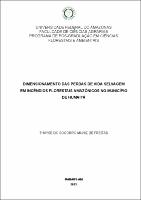| ???jsp.display-item.social.title??? |


|
Please use this identifier to cite or link to this item:
https://tede.ufam.edu.br/handle/tede/9963| ???metadata.dc.type???: | Dissertação |
| Title: | Dimensionamento das perdas de vida selvagem em incêndios florestais amazônicos no município de Humaitá |
| Other Titles: | Dimensioning wildlife losses in Amazonian forest fires in the municipality of Humaitá |
| ???metadata.dc.creator???: | Freitas, Thayse do Socorro Muniz de  |
| ???metadata.dc.contributor.advisor1???: | Fonseca, Rogerio |
| ???metadata.dc.contributor.referee1???: | Scudeller, Veridiana Vizoni |
| ???metadata.dc.contributor.referee2???: | Souza, Luiz Joaquim bacelar de |
| ???metadata.dc.description.resumo???: | No município de Humaitá em 2022 os índices são um recorde de focos de calor, segundo dados históricos do Instituto Nacional de Pesquisas Espaciais (INPE), que registrou 1175 focos de calor ativos. No Brasil, a maior parte dos trabalhos realizados sobre o fogo aborda questões relacionadas à adaptação das plantas aos efeitos do fogo, dinâmica de nutrientes e descrição do comportamento do fogo. Assim, é necessário entender onde e quando ocorrem os incêndios florestais, e suas principais causas, porque, ao se conhecerem estes fatores, pode-se estabelecer um meio eficaz para precaver ou minimizar suas consequências sobre a fauna. Portanto, o presente trabalho teve como objetivo identificar as causas dos incêndios florestais/queimada, e estimar o número de animais mortos por esses riscos naturais/antropogênico no município de Humaitá no período de 2018 a 2022. Para isto, a pesquisa realizou entrevistas semiestruturadas e um questionário, utilizando uma técnica inovadora que consiste em uma síntese de amostragem “snowball” (“Bola de Neve”). Entre 2018 e 2022, foram registradas 528 ocorrências pelo corpo de bombeiros. Os resultados mostraram que 88% das áreas afetadas ocorreram no período seco entre julho e outubro. A causa principal foi “queima para limpeza” com 95%, estatisticamente superior às outras causas. No que diz respeito à fauna, os dados obtidos mostram que a vida selvagem (fauna) não é considerada um ativo ambiental e, portanto, houve uma baixa quantidade de animais visualizados, resgatados e atendidos em consequência dos incêndios. Nos últimos cinco anos apenas dois casos foram registrados, evidenciando que a fauna não é relevante como ativo ambiental ou coleta de informações em campo para promover resgates é inadequada. Esses resultados reforçam a necessidade de programas de educação ambiental para conscientizar a população sobre a conservação da biodiversidade. |
| Abstract: | In the municipality of Humaitá in 2022 the indices are a record of hot spots, according to historical data from the National Institute for Space Research (INPE), which recorded 1175 active hot spots. In Brazil, most of the work carried out on fire addresses issues related to plant adaptation to the effects of fire, nutrient dynamics and description of fire behavior. Thus, it is necessary to understand where and when forest fires occur, and their main causes, because, by knowing these factors, an effective means can be established to prevent or minimize their consequences on the fauna. Therefore, the present work aimed to identify the causes of forest fires/burning, and to estimate the number of animals killed by these natural/anthropogenic risks in the municipality of Humaitá in the period from 2018 to 2022. Between 2018 and 2022, 528 occurrences were recorded by the fire department. The results showed that 88% of the affected areas occurred in the dry period between July and October. The main cause was “burning for cleaning” with 95%, statistically higher than the other causes. With regard to fauna, the data obtained show that wildlife (fauna) is not considered an environmental asset and, therefore, there was a low number of animals seen, rescued and attended to as a result of the fires. In the last five years, only two cases were recorded, showing that the fauna is not relevant as an environmental asset or the collection of information in the field to promote rescues is inadequate. These results reinforce the need for environmental education programs to make the population aware of biodiversity conservation. |
| Keywords: | Incêndios florestais - Humaitá (AM) Desmatamento - Amazônia Animais silvestres - Proteção |
| ???metadata.dc.subject.cnpq???: | CIENCIAS BIOLOGICAS: ZOOLOGIA: ZOOLOGIA APLICADA: CONSERVACAO DAS ESPECIES ANIMAIS |
| ???metadata.dc.subject.user???: | Incêndio Florestal Fauna Queimada Fogo Vida Selvagem |
| Language: | por |
| ???metadata.dc.publisher.country???: | Brasil |
| Publisher: | Universidade Federal do Amazonas |
| ???metadata.dc.publisher.initials???: | UFAM |
| ???metadata.dc.publisher.department???: | Centro de Ciências do Ambiente |
| ???metadata.dc.publisher.program???: | Programa de Pós-graduação em Ciências Florestais e Ambientais |
| Citation: | FREITAS, Thayse do Socorro Muniz de Dimensionamento das perdas de vida selvagem em incêndios florestais amazônicos no município de Humaitá, 2023. 44 f. Dissertação (Mestrado em Ciências Florestais e Ambientais ) - Universidade Federal do Amazonas, Manaus (AM), 2023. |
| ???metadata.dc.rights???: | Acesso Aberto |
| ???metadata.dc.rights.uri???: | https://creativecommons.org/licenses/by-nc-nd/4.0/ |
| URI: | https://tede.ufam.edu.br/handle/tede/9963 |
| Issue Date: | 28-Jul-2023 |
| Appears in Collections: | Mestrado em Ciências Florestais e Ambientais |
Files in This Item:
| File | Description | Size | Format | |
|---|---|---|---|---|
| DISS_ThayseMuniz_PPGCIFA.pdf | 2.36 MB | Adobe PDF |  Download/Open Preview |
Items in DSpace are protected by copyright, with all rights reserved, unless otherwise indicated.




